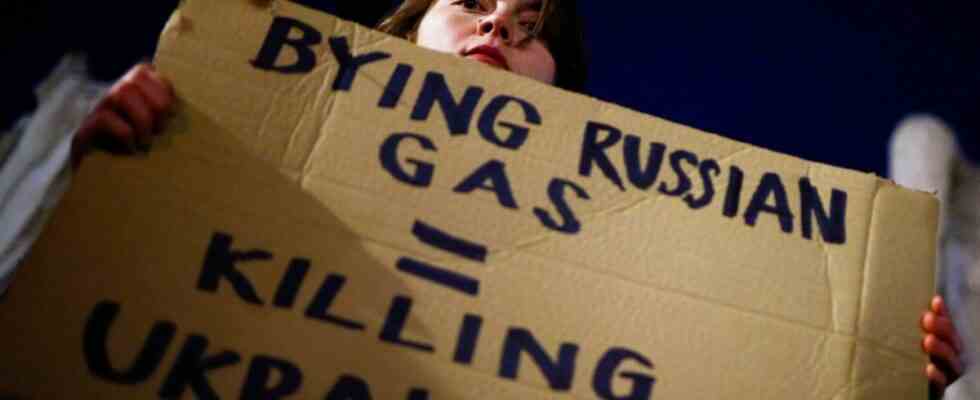“Without Russian gas,” was the headline in the Milan newspaper Corriere della Sera a few days ago, “we will experience a cold autumn.” That was meant literally, but also metaphorically for the big picture.
The Italians are only just realizing how dependent they have become on gas supplies from abroad, especially from Russia. And since they not only use gas for heating and cooking, but also generate a considerable part of their electricity needs through combustion, the concern is perhaps even greater than in other countries now that the war in Ukraine has shattered certainties. Spring is almost here, and summer shouldn’t be a problem either – but autumn is looming like a dark threat.
Prime Minister Mario Draghi recently said in Parliament that it is not impossible that gas consumption will have to be rationed, at least for industry. You are now paying for short-sighted strategies, for selling out your own autonomy, for an inadequate energy mix. In 1980, when the country was only consuming around 40 billion cubic meters of gas a year, it was still producing almost half of it itself on the 115 offshore platforms, mainly in the upper part of the Adriatic. Production has been cut more and more over the past twenty years, and oil rigs have fallen out of fashion along with fossil fuels. Italy now uses almost twice as much gas as it did four decades ago, but only produces 3.5 billion cubic meters itself.
The rest comes through pipelines from Russia (about 40 percent), Algeria (28 percent), Azerbaijan (9 percent), Libya (4 percent), to name just the major suppliers. Qatar sends liquefied gas on freighters, which is turned into gas at three Italian locations. In the camps of Livorno, Panigaglia and Cavarzere the majority of the Italian reserves are then also to be found.
That’s not much: If all gas deliveries from abroad were stopped tomorrow, it would be enough for eight weeks, says Roberto Cingolani, Minister for Ecological Conversion. Of course, the Italians are now trying to make even better use of the existing channels and increase import volumes from non-Russian sources in order to evade possible blackmail from Moscow. They do this on their own so that it might go a little faster. Since the outbreak of war, Foreign Minister Luigi Di Maio already Algeria and Qatar toured, he took the boss of the Italian oil and energy group Eni with him.
All reports and background information on the war in Ukraine – in the SZ in the morning and in the SZ in the evening. Our Messages–Newsletter brings you up to date twice a day. Free registration at sz.de/morgenabend. In our news app (download here) you can also subscribe to the news newsletter or our breaking news as a push message.
The only way out – a relapse into outdated times
Negotiations with Qatar are difficult because the Gulf State has long-term commitments to customers in the Far East. Things went better with Algeria: About them Trans-Mediterranean Pipeline recently more gas comes to Italy than from Russia. They expect more from Azerbaijan too, the new one Trans Adriatic Pipeline is only half full. And then there is Libya, the former colony. The Italians used to get a lot of gas from there, it’s so close. But when it became apparent that Muammar al-Gaddafi was using the dependency politically, new suppliers were sought. But you didn’t learn much from it.
Studies now show that Italy could only compensate for about half of a total failure of Russian gas with more of its own, as well as Algerian, Azerbaijani and Libyan gas. There is a shortage of around 15 billion cubic meters per year, which is quite a lot.
Actually, you didn’t want to see such monsters anymore, but now Italy’s government is facilitating new drilling for gas and oil: production platform of the Italian energy company Eni off the Adriatic coast.
(Photo: Alberto Pizzoli/AFP)
The alternatives? Italy has no nuclear power plants. And renewable energy sources are not easy to develop, it takes a lot of time and a good part of it is bureaucracy. In the short term, there is only one way out, which Draghi named with a resigned undertone during his appearance in parliament: the government has instructed six coal-fired power plants in the country to get ready to start up their production again, he said.
Italy had committed to phase out all of its coal-fired power plants by 2025 as a contribution to reducing CO₂ emissions. The works represent about eight percent of the total Italian air pollution. The one in La Spezia has already been closed, the others have reduced production.
In Monfalcone in the extreme north-east, where the closure was imminent, the decision was made with great relief: the name of the place symbolizes how unhealthy unclean energy is for people and the environment. Now it could be that Monfalcone falls back into dramatic times because of Vladimir Putin.
Suddenly the “Trivelle” are a topic again, that’s what the controversial drilling rigs are called. So far, there has always been strong resistance to this, not only from ecological reasons, but also from aesthetic ones. And now? Cingolani announced that the government has simplified procedures for approving new rigs. From the mouth of the minister, who is supposed to make Italy’s energy production more environmentally friendly, that is a remarkable statement.

